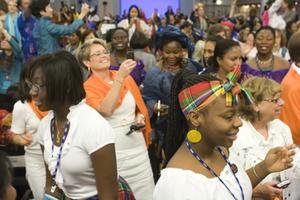Content Type
Researchers are investigating the impact of offering financial incentives to people who are at risk of acquiring or passing on HIV. In sub-Saharan Africa, a number of studies are investigating whether providing incentives to adolescent girls who remain in education reduces their long-term HIV risk. Read full article…
In Dushanbe, the Tajikistan Network of Women Living with HIV (TNW+) and the Centre for Mental Health and HIV/AIDS (MHAIDS), hosted the first National Forum of Women Living with HIV, "Women in Tajikistan for a future without AIDS." Read full article…

“I just wanted to make a difference and change women’s lives. More women need to be empowered, have a voice and be able to stand up for their rights…
 I am Mariana Iácono, from Buenos Aires, Argentina. I’m a social worker and student of history. I love swimming in the sea if there are no jellyfish. I love reading and practicing sports. I work in education in two high-schools and I’m also a HIV/…
I am Mariana Iácono, from Buenos Aires, Argentina. I’m a social worker and student of history. I love swimming in the sea if there are no jellyfish. I love reading and practicing sports. I work in education in two high-schools and I’m also a HIV/…
A two-year, seven-country study has concluded that women using hormonal contraceptives, particularly injectable forms, are at a greater risk both of acquiring HIV themselves and of passing it on to a male sexual partner. Read full article here.
Two studies of the use of oral pre-exposure prophylaxis (PrEP) in heterosexual people show that oral PrEP will protect women against HIV. Read full article here.
On the periphery of the IAS 2011 conference, UNAIDS in collaboration with the GCWA, ATHENA, Salamander Trust, WECARe+ and Network Persone Seropositive convened a town hall dialogue to discuss how the HIV response facilitates the achievement of sexual and reproductive health and rights for all women. Read full article here…
The Indian Council of Medical Research (ICMR) will soon begin behavioural and social science research on microbicides for HIV prevention. This could potentially offer Indian women safe, effective, acceptable and affordable protection against this deadly disease. Read full article here.
“SHE” – Strong, HIV Positive, Empowered Women – the first comprehensive European patient education programme to address the growing challenges faced by women living with HIV, was launched at the 6th IAS Conference in Rome, Italy. Read full article here.
Vitamin A deficiency (VAD) is known to be a major public health problem among women of reproductive age in South East Asia and Africa. In Ethiopia, there are no studies conducted on serum vitamin A status of HIV-infected pregnant women. Read full article …
A new study led by researchers at the Johns Hopkins Bloomberg School of Public Health shows that community members correlate an increase in HIV vulnerability among adolescent girls with weak structural support systems. Read full article here.
IMPHAL: Hordes of NGOs, including the Manipur Network of Positive People, have asked the state government to order a reinvestigation into the recent death of an HIV-positive woman here. Read full article here.
In a densely packed sub-urban township far away from Lutyen’s Delhi, at a small house encased in a cacophony of concrete flats, about 20 women engaged in sex work got together to share their experiences of the AIDS response. Read full article here.
Yesterday, a federal appeals court in New York ruled that the US cannot force organizations to formally pledge to denounce prostitution and sex trafficking in order to receive US funding for HIV and AIDS work. Read full article here.
A small, qualitative study of about 60 women in two clinics in the Durban area, found that while two-thirds of the women did tell their partners they were HIV positive, only half of them reported that their partner had been tested for HIV as a result. Read full article here.